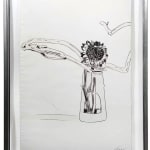Andy Warhol USA, 1928-1987
Flowers [Black & White], 1974
Original screen print initialled by the artist lower right,
Signed by the artist, on verso
F & S 11.102
Signed by the artist, on verso
F & S 11.102
102.87 x 69.21 cm - paper size
124.46 x 90.17 cm - Framed
124.46 x 90.17 cm - Framed
© The Estate of Andy Warhol
Further images
Travelling to Tokyo, Japan, in 1974 for his first solo exhibition in the country, Andy Warhol was inspired by ikebana, the traditional art form of arranging flowers with symbolic meaning...
Travelling to Tokyo, Japan, in 1974 for his first solo exhibition in the country, Andy Warhol was inspired by ikebana, the traditional art form of arranging flowers with symbolic meaning in Japan. Here, his collection of Flowers draws inspiration from 19th-century Japanese woodblock prints, showing Warhol's engagement with traditional artistic forms and his interest in Japanese culture.
This series also reflects Warhol's early career as a commercial illustrator, resonating strongly with the strong lines of his illustrations from the 1950s. The delicate rendering and attention to detail in these flower prints harken back to his work for fashion magazines and advertising, highlighting his skill as a draftsman.
Creating this series of Flowers a decade after his vibrant Pop Art compositions of the hibiscus, Warhol continued to explore the duality of nature and Pop in his work by returning to floral themes with a different aesthetic approach. The black and white series serves as a testament to his enduring fascination with nature as a subject, albeit approached from a more contemplative and introspective perspective than his earlier Pop Art flowers from the 1960s.
This series also reflects Warhol's early career as a commercial illustrator, resonating strongly with the strong lines of his illustrations from the 1950s. The delicate rendering and attention to detail in these flower prints harken back to his work for fashion magazines and advertising, highlighting his skill as a draftsman.
Creating this series of Flowers a decade after his vibrant Pop Art compositions of the hibiscus, Warhol continued to explore the duality of nature and Pop in his work by returning to floral themes with a different aesthetic approach. The black and white series serves as a testament to his enduring fascination with nature as a subject, albeit approached from a more contemplative and introspective perspective than his earlier Pop Art flowers from the 1960s.
Publications
Feldman & Schellmann: Andy Warhol Prints, A catalogueRaisonne 1962/1987 : Number 11.102Join our mailing list
* denotes required fields
We will process the personal data you have supplied to communicate with you in accordance with our Privacy Policy. You can unsubscribe or change your preferences at any time by clicking the link in our emails.
![Andy Warhol, Flowers [Black & White], 1974](https://artlogic-res.cloudinary.com/w_1600,h_1600,c_limit,f_auto,fl_lossy,q_auto/artlogicstorage/dellasposa/images/view/dc073a9ec5b2ff4a8f452c1a7b41d5a0j/dellasposa-andy-warhol-flowers-black-white-1974.jpg)
![Andy Warhol, Flowers [Black & White], 1974](https://artlogic-res.cloudinary.com/w_1600,h_1600,c_limit,f_auto,fl_lossy,q_auto/artlogicstorage/dellasposa/images/view/2d84b97b15d55eb3acf2133a7c41296ej/dellasposa-andy-warhol-flowers-black-white-1974.jpg)
![Andy Warhol, Flowers [Black & White], 1974](https://artlogic-res.cloudinary.com/w_1600,h_1600,c_limit,f_auto,fl_lossy,q_auto/artlogicstorage/dellasposa/images/view/561572ee2bd267863981227b62a10fc3j/dellasposa-andy-warhol-flowers-black-white-1974.jpg)
![Andy Warhol, Flowers [Black & White], 1974](https://artlogic-res.cloudinary.com/w_1600,h_1600,c_limit,f_auto,fl_lossy,q_auto/artlogicstorage/dellasposa/images/view/b025696c01ab8107f7e9b170386358faj/dellasposa-andy-warhol-flowers-black-white-1974.jpg)



